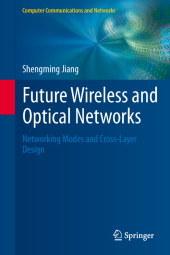 Neuerscheinungen 2014Stand: 2020-02-01 |
Schnellsuche
ISBN/Stichwort/Autor
|
Herderstraße 10
10625 Berlin
Tel.: 030 315 714 16
Fax 030 315 714 14
info@buchspektrum.de |

Shengming Jiang
Future Wireless and Optical Networks
Networking Modes and Cross-Layer Design
2012. 2014. xviii, 250 S. 235 mm
Verlag/Jahr: SPRINGER, BERLIN; SPRINGER, LONDON; SPRINGER 2014
ISBN: 1-447-16228-5 (1447162285)
Neue ISBN: 978-1-447-16228-5 (9781447162285)
Preis und Lieferzeit: Bitte klicken
The future internet must integrate optical wired and wireless mobile networks to meet the demand for pervasive capacity. This volume examines a number of modifications to existing layered reference models that feature cross-layer design and optimization.
This book reviews the challenges of all-optical and wireless networks for the future Internet, with a focus on cross-layer design and optimization. Features: presents a thorough introduction to major networking modes and their effect on Internet development; proposes a new structure favorable for all-optical packet switching; discusses a new quality of service (QoS) provisioning approach, which overcomes the scalability problem of IntServ and the coarse QoS granularity of DiffServ; describes the end-to-end arguments in Internet design, before investigating a solution to congestion control problems in multi-hop wireless and all-optical networks; examines how to exploit multiple-input-multiple-output technology to improve network performance in centralized wireless networks; surveys green networking strategies from a quantitative perspective; suggests a strategic vision for possible developments of network technology for the future Internet.
Introduction and Overview
Internet Development versus Networking Modes
Two-Level Source Routing (TLSR) for All-Optical Packet Switching
Networking with TLSR
Differentiated Queueing Service (DQS) for Granular QoS
Cost Model for Granular End-to-End QoS with DQS
Quantitative End-to-End Arguments: Performance Analysis
Quantitative End-to-End Arguments: Complexity Estimation
Numerical Discussion of Quantitative End-to-End Arguments
Decoupling Congestion Control from TCP: Semi-TCP
Enabling Simultaneous MAC Transmission with MIMO: Logical MIMO
Numerical Evaluation of MAC Schemes Based on Physical and Logical MIMO
To Be Continued


